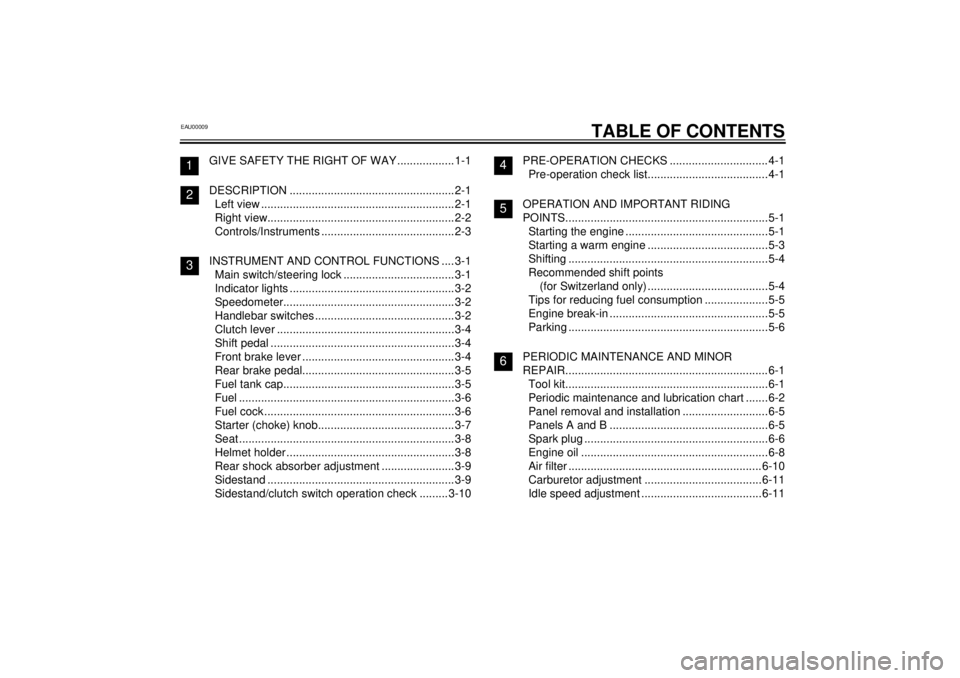2000 YAMAHA SR125 light
[x] Cancel search: lightPage 7 of 78

EAU00009
TABLE OF CONTENTS
GIVE SAFETY THE RIGHT OF WAY ..................1-1
DESCRIPTION ....................................................2-1
Left view ............................................................. 2-1
Right view...........................................................2-2
Controls/Instruments ..........................................2-3
INSTRUMENT AND CONTROL FUNCTIONS ....3-1
Main switch/steering lock ................................... 3-1
Indicator lights ....................................................3-2
Speedometer......................................................3-2
Handlebar switches ............................................3-2
Clutch lever ........................................................3-4
Shift pedal ..........................................................3-4
Front brake lever ................................................ 3-4
Rear brake pedal................................................ 3-5
Fuel tank cap......................................................3-5
Fuel ....................................................................3-6
Fuel cock ............................................................3-6
Starter (choke) knob...........................................3-7
Seat ....................................................................3-8
Helmet holder .....................................................3-8
Rear shock absorber adjustment .......................3-9
Sidestand ...........................................................3-9
Sidestand/clutch switch operation check ......... 3-10PRE-OPERATION CHECKS ...............................4-1
Pre-operation check list......................................4-1
OPERATION AND IMPORTANT RIDING
POINTS................................................................5-1
Starting the engine .............................................5-1
Starting a warm engine ......................................5-3
Shifting ...............................................................5-4
Recommended shift points
(for Switzerland only) ......................................5-4
Tips for reducing fuel consumption ....................5-5
Engine break-in ..................................................5-5
Parking ...............................................................5-6
PERIODIC MAINTENANCE AND MINOR
REPAIR................................................................6-1
Tool kit................................................................6-1
Periodic maintenance and lubrication chart .......6-2
Panel removal and installation ...........................6-5
Panels A and B ..................................................6-5
Spark plug ..........................................................6-6
Engine oil ...........................................................6-8
Air filter .............................................................6-10
Carburetor adjustment .....................................6-11
Idle speed adjustment ......................................6-11
123
456
E_3mw.book Page 1 Monday, February 5, 2001 9:54 AM
Page 8 of 78

TABLE OF CONTENTS
Throttle cable free play adjustment .................. 6-12
Cam chain adjustment ..................................... 6-12
Valve clearance adjustment ............................. 6-13
Tires ................................................................. 6-13
Wheels ............................................................. 6-15
Clutch lever free play adjustment..................... 6-16
Front brake lever free play adjustment ............ 6-16
Rear brake pedal height and free play
adjustment .................................................... 6-17
Brake light switch adjustment .......................... 6-18
Checking the front brake pads and
rear brake shoes .......................................... 6-19
Inspecting the brake fluid level......................... 6-20
Brake fluid replacement ................................... 6-20
Drive chain slack check ................................... 6-21
Drive chain slack adjustment ........................... 6-22
Drive chain lubrication...................................... 6-23
Cable inspection and lubrication ...................... 6-23
Throttle cable and grip lubrication .................... 6-23
Brake and shift pedal lubrication ...................... 6-24
Brake and clutch lever lubrication .................... 6-24
Center and sidestand lubrication ..................... 6-24
Front fork inspection ........................................ 6-25
Steering inspection .......................................... 6-26
Wheel bearings ................................................ 6-26
Battery.............................................................. 6-26
Fuse replacement ............................................ 6-28
Headlight bulb replacement ............................. 6-29Turn signal and tail/brake light bulb
replacement.................................................. 6-30
Front wheel removal ........................................ 6-30
Front wheel installation .................................... 6-31
Rear wheel removal ......................................... 6-32
Rear wheel installation ..................................... 6-33
Troubleshooting ............................................... 6-33
Troubleshooting chart ...................................... 6-34
MOTORCYCLE CARE AND STORAGE ............. 7-1
Care ................................................................... 7-1
Storage .............................................................. 7-4
SPECIFICATIONS ............................................... 8-1
Specifications ..................................................... 8-1
How to use the conversion table ........................ 8-5
CONSUMER INFORMATION.............................. 9-1
Identification number records............................. 9-1
Key identification number................................... 9-1
Vehicle identification number ............................. 9-1
Model label......................................................... 9-2
789
E_3mw.book Page 2 Monday, February 5, 2001 9:54 AM
Page 13 of 78

3-1
3
EAU00027
3-INSTRUMENT AND CONTROL FUNCTIONS
EAU00029*
Main switch/steering lockThe main switch controls the ignition
and lighting systems. Its operation is
described below.
EAU00036
ON
Electrical circuits are switched on. The
engine can be started. The key cannot
be removed in this position.
EAU00038
OFF
All electrical circuits are switched off.
The key can be removed in this posi-
tion.
EAU00040
LOCK
The steering is locked in this position
and all electrical circuits are switched
off. The key can be removed in this po-
sition.
To lock the steering, turn the handle-
bars all the way to the left. While push-
ing the key into the main switch, turn it
from “OFF” to “LOCK” and remove it.
To release the lock, turn the key to
“OFF” while pushing.
EW000016
WARNING
@ Never turn the key to “OFF” or
“LOCK” when the motorcycle is
moving. The electrical circuits will
be switched off which may result in
loss of control or an accident. Be
sure the motorcycle is stopped be-
fore turning the key to “OFF” or
“LOCK”. @1. Push
2. Turn
E_3mw.book Page 1 Monday, February 5, 2001 9:54 AM
Page 14 of 78

INSTRUMENT AND CONTROL FUNCTIONS
3-2
3
EAU00056
Indicator lights
EAU00061
Neutral indicator light “ ”
This indicator comes on when the
transmission is in neutral.
EAU00057
Turn indicator light “ ”
This indicator flashes when the turn
switch is moved to the left or right.
EAU00063
High beam indicator light “ ”
This indicator comes on when the
headlight high beam is used.
EAU00095*
SpeedometerThe speedometer shows riding speed.
This speedometer is equipped with an
odometer and tripmeter. The tripmeter
can be reset to “0” with the reset knob.
Use the tripmeter to estimate how far
you can ride on a tank of fuel. This in-
formation will enable you to plan fuel
stops in the future.
EAU00118
Handlebar switches
EAU00134
Lights switch
Turning the light switch to “ ”,
turns on the auxiliary light, meter lights
and taillight. Turning the light switch to
“ ” turns the headlight on also.
EAU00121
Dimmer switch
Turn the switch to “ ” for the high
beam and to “ ” for the low beam.
1. Neutral indicator light “ ”
2. Turn indicator light “ ”
3. High beam indicator light “ ”
1. Reset knob
2. Tripmeter
3. Odometer
4. Speedometer
1. Lights switch
2. Dimmer switch
3. Turn signal switch
4. Horn switch “ ”
E_3mw.book Page 2 Monday, February 5, 2001 9:54 AM
Page 24 of 78

PRE-OPERATION CHECKS
4-2
4
NOTE:Pre-operation checks should be made each time the motorcycle is used. Such an inspection can be thoroughly accom-
plished in a very short time; and the added safety it assures is more than worth the time involved.
WARNING
If any item in the PRE-OPERATION CHECK is not working properly, have it inspected and repaired before operating
the motorcycle.Center and sidestand
pivot• Check for smooth operation.
• Lubricate if necessary.6-24
Chassis fasteners• Make sure that all nuts, bolts and screws are properly tightened.
• Tighten if necessary.—
Fuel• Check fuel level.
• Fill with fuel if necessary.3-5 ~ 3-6
Lights, signals and
switches• Check for proper operation. 6-29 ~ 6-30
Battery• Check fluid level.
• Fill with distilled water if necessary.6-26 ~ 6-28 ITEM CHECKS PAGEE_3mw.book Page 2 Monday, February 5, 2001 9:54 AM
Page 27 of 78

OPERATION AND IMPORTANT RIDING POINTS
5-3
5 1. Turn the fuel cock to “ON”.
2. Turn the main switch to “ON” and
the engine stop switch to “ ”.
3. Shift the transmission into neutral.
NOTE:@ When the transmission is in neutral, the
neutral indicator light should be on. If
the light does not come on, ask a
Yamaha dealer to inspect it. @4. Turn on the starter (choke) and
completely close the throttle grip.
5. Start the engine by pushing the
start switch.NOTE:@ If the engine fails to start, release the
start switch, wait a few seconds, then
try again. Each attempt should be as
short as possible to preserve the bat-
tery. Do not crank the engine more
than 10 seconds on any one attempt. @
6. After starting the engine, move the
starter (choke) to the halfway posi-
tion.NOTE:@ For maximum engine life, never accel-
erate hard with a cold engine! @7. After warming up the engine, turn
off the starter (choke) completely.NOTE:@ The engine is warm when it responds
normally to the throttle with the starter
(choke) turned off. @
EAU01258
Starting a warm engineThe starter (choke) is not required
when the engine is warm.
EC000046
CAUTION:@ See the “Engine break-in” section
prior to operating the motorcycle for
the first time. @
E_3mw.book Page 3 Monday, February 5, 2001 9:54 AM
Page 28 of 78

OPERATION AND IMPORTANT RIDING POINTS
5-4
5
EAU00423
ShiftingThe transmission lets you control the
amount of power you have available at
a given speed for starting, accelerating,
climbing hills, etc. The use of the shift
pedal is shown in the illustration.
To shift into neutral, depress the shift
pedal repeatedly until it reaches the
end of its travel, then raise the pedal
slightly.
EC000048
CAUTION:@ l
Do not coast for long periods
with the engine off, and do not
tow the motorcycle a long dis-
tance. Even with gears in neu-
tral, the transmission is only
properly lubricated when the
engine is running. Inadequate
lubrication may damage the
transmission.
l
Always use the clutch when
changing gears. The engine,
transmission, and driveline are
not designed to withstand the
shock of forced shifting and can
be damaged by shifting without
using the clutch.
@
EAU02941
Recommended shift points
(for Switzerland only)The recommended shift points are
shown in the table below.CF-25ENOTE:@ When shifting two gears down from 4th
to 2nd, bring your motorcycle to a
speed of 35 km/h. @
1. Shift pedal
N. Neutral
Acceleration shift point
(km/h)
1st®2nd
2nd®3rd
3rd®4th
4th®5th23
36
50
60
E_3mw.book Page 4 Monday, February 5, 2001 9:54 AM
Page 29 of 78

OPERATION AND IMPORTANT RIDING POINTS
5-5
5
EAU00424
Tips for reducing fuel
consumptionYour motorcycle’s fuel consumption
depends to a large extent on your
riding style. The following tips can help
reduce fuel consumption:l
Warm up the engine before riding.
l
Turn off the starter (choke) as
soon as possible.
l
Shift up swiftly and avoid high en-
gine speeds during acceleration.
l
Do not double-clutch or rev the en-
gine while shifting down and avoid
high engine speeds with no load
on the engine.
l
Turn off the engine instead of let-
ting it idle for an extended length
of time, i.e. in traffic jams, at traffic
lights or railroad crossings.
EAU00436
Engine break-inThere is never a more important period
in the life of your motorcycle than the
period between zero and 1,000 km. For
this reason we ask that you carefully
read the following material. Because
the engine is brand new, you must not
put an excessive load on it for the first
1,000 km. The various parts in the en-
gine wear and polish themselves to the
correct operating clearances. During
this period, prolonged full throttle oper-
ation, or any condition which might re-
sult in excessive heating of the engine,
must be avoided.
E_3mw.book Page 5 Monday, February 5, 2001 9:54 AM